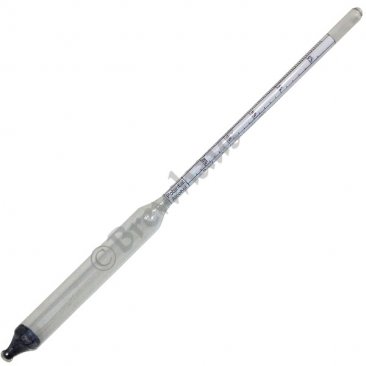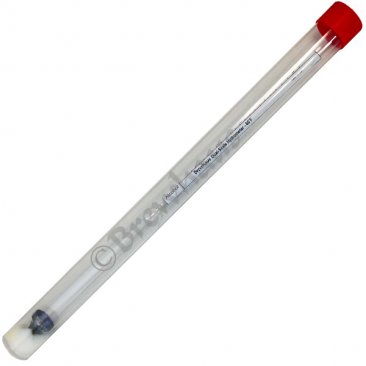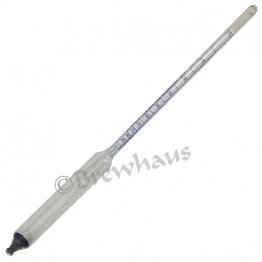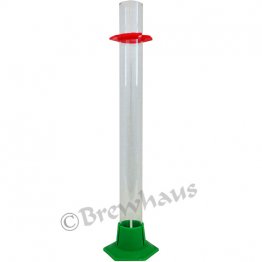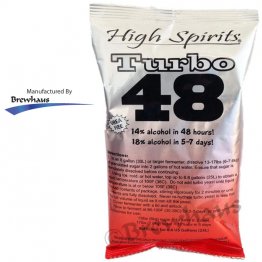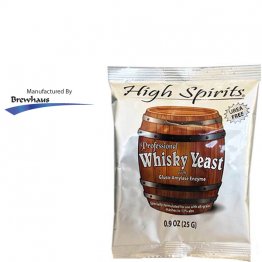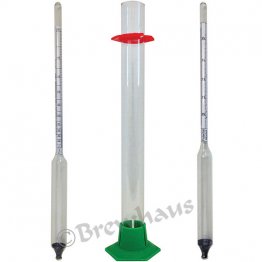Hydrometer- 30cm- dual scale- Premium
Hydrometers are for reading density of a mash, and are used to confirm completion of fermentation, or to calculate the alcohol content from fermentation by using readings at the start and end of fermentation. Hydrometers will not work in a distilled spirit.
Has both Specific Gravity Scale and Potential Alcohol scale. 0.980 to 1.170 Specific Gravity reading (
30cm (12'') long laboratory grade Hydrometer.
A hydrometer measures the density of a liquid compared to water. For our purposes, this is for finding the potential alcohol that will be obtained through fermentation, as well as the actual fermented alcohol percentage through a simple calculation. A hydrometer will not work for testing the alcohol percentage in a finished product, however. Water is more dense than alcohol, therefore a hydrometer's use is restricted to finding density when compared to water, and not alcohol. To test alcohol percentage in a finished product, you need an alcoholmeter.
While there are several scales used on hydrometers, those most commonly used in home brewing are Specific Gravity, Oeschle, and Potential Alcohol. Because the Potential Alcohol scale is included on only some hydrometers, and can be easily calculated from the Specific Gravity or Oeschle reading, we will focus on these two scales.
The two scales- Specific Gravity and Oeschle- are directly related. This makes it easy to convert the reading for any reason. This can be very important if, for example, your hydrometer breaks between readings, and your replacement uses the opposing scale only. While Specific Gravity reads in decimals, Oeschle scale reads in whole numbers. As an example, a Specific Gravity reading of 1.090 is the same as an Oeschle reading of 90. SG 1.055 is Oeschle 55, and so on. You simply remove the 1 before the decimal, and multiply by 1000 to convert a Specific Gravity reading to an Oeschle reading The advantage to the Oeschle scale is that instead of reading in decimals below 1.000, it goes into the negative scale. This can simplify some calculations that you may use the numbers for. This is because in Specific Gravity, water is 1.000, whereas in Oeschle water is 0. While with experience one can become comfortable with Specific Gravity, many starting out find calculations with a finishing SG below 1.000 to become very confusing.

In order to make full use of your hydrometer the first thing that you need to know how to do is to take a reading with it. In order to take a reading, pour a sample of the liquid to be tested into your test cylinder, leaving room for the hydrometer to displace the liquid. In order to obtain the most accurate reading possible, try to ensure that the liquid is as close to 60'F as possible, as this is the temperature that the hydrometer has been calibrated to (should your hydrometer be calibrated to a different temperature, which should be stated on the meter, ensure that your liquid is at the quoted temperature). Place your hydrometer in the liquid and spin it in order to dislodge any bubbles that may be in the liquid, which would otherwise cause you to get a false high reading. Read the number on the paper where the liquid crosses the stem of the hydrometer.
There are multiple uses for taking readings of your mash. First, you can use a reading taken prior to pitching your yeast to calculate the potential alcohol that will be achieved through the fermentation. This calculation generally assumes an ending reading of SG 1.000 (Oeschle 0):
Original Reading- SG 1.090 (Oeschle 90)
For SG reading subtract 1 and multiply by 125
1.090 - 1 = 0.090 x 125 = 11.25% potential alcohol
For Oeschle reading divide by 8
90 ÷ 8 = 11.25% potential alcohol
You can also use virtually the same calculation to find the actual fermented alcohol percentage by taking the difference between the original reading (prior to pitching yeast) and the final reading (after fermentation is complete). For example, if your original reading is SG 1.090 (Oeschle 90), and your final reading is SG 0.990 (Oeschle -10):
SG 1.090 - 0.990 = 0.1 x 125 = 12.5% alcohol
Oeschle 90 - (-10) = 100 ÷ 8 = 12.5% alcohol
Remember basic math- when subtracting a negative number, you add the two numbers together
A hydrometer can also be used to check that fermentation has completed. To do this, you will take a reading two days apart and compare the results. If there is any change in the results, then your fermentation was still active during this period. If the reading remains stagnant, then fermentation is completed and you may move to the next stage of the process.
-
Bill FleemorMay 25, 2020, 12:00 AMHydrometer- 30cm- dual scale- Premium. This is a very good quality item for checking potential alcohol in your mash and final alcohol in your product.
-
JimSep 7, 2013, 12:00 AMBuy two at this price, guarantee you'll need a backup. This is such a good price, buy two. You'll need a backup when you drop the first one. Look, it's cheaper than the mailing cost when you hafta buy the replacement three months from now. Me, it was the third batch, bang!
-
BayouRulerApr 13, 2011, 12:00 AMNice......................... Hydrometer @ an economical price!!



